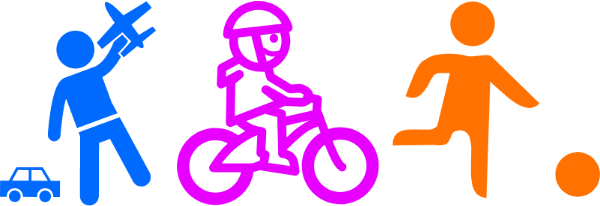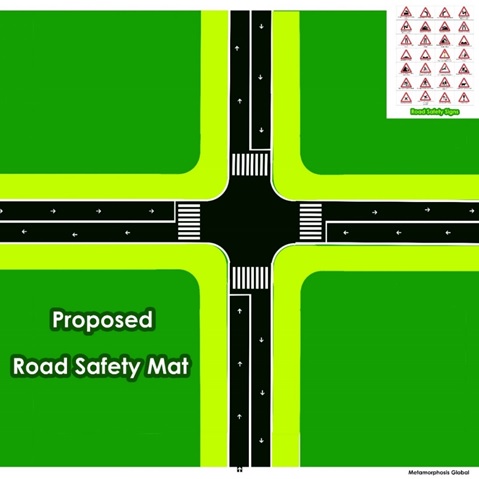Child-friendly neighbourhoods



Road Safety Mat, Bangladesh

Summary
The proposal is that a mat should be used by the children for improving road safety awareness and to create a child friendly environment. The goal is to create awareness about road safety issues and to improve the current road environment by making it more child friendly. This mat will be accompanied by other elements, such as toy car/bike, dummy traffic signals and signs. It will be a tool for enjoyment by learning through playing.
Context
A growing epidemic of traffic injuries is devastating the next generation of children around the globe. BSAF (Bangladesh Shishu Adhikar Forum) data shows that a total of 549 children died in road accidents from January to October of 2018, and 79 were injured during the period. One of the major reasons is there is no safety raising activity that is especially addressing the children. A road safety mat can be a good measure to create consciousness, to acquire practical road safety knowledge and also can serve the purpose of creating a child-friendly street environment.
Transformational measures and activities
The children’s road safety training mat will be a foldable miniature model complete with roads, traffic control devices such as traffic signs, pavement markings, zebra crossing, bus stops and different common abutting amenities. It will be made of heavy duty PVC materials for long time use. Because of its portability feature and demonstration friendliness, good use of it will be ensured. Moreover, there is a big opportunity in introducing this as an activity based lesson, aligning it with the school routine.
The mat will be designed to meet the needs of both the theoretical as well as practical aspects of training on issues of road safety. In this regard, a short user’s manual will be developed by involving children, guardians, teachers and safety experts. It will be used by the students from the age of five, as well as by other organised youth groups. Its aim is to inculcate in the minds of the children the road safety values and to improve children’s knowledge, skills and behaviour as road users. Thus, it will create a child-friendly road environment for all. Children will also have an understanding of the other road users’ perspectives by giving them the opportunity to be the drivers through driving a special type of toy vehicle and as cyclists by riding a bicycle.
The following are proposed:
- A small-scale version of a network of roads and landmarks that allows children to explore traffic rules and move around with pedal go-karts, or on foot.
- Children will be excited to know that even the roads, pavements, lampposts and traffic lights are all designed in a miniature scale especially for them.
- A game will also involve with the children tasks with a list of errands to complete within a fixed amount of time.
- In their roles as cyclists, drivers and pedestrians, they are expected to observe proper road safety rules and etiquette, or be penalised by the mat marshals monitoring their movement.
- Learning to raise their hands while crossing the zebra crossing, reading road signs, coming to a stop when the traffic lights turn from yellow to red are just a few of the road safety measures kids can practice at the mat.
- There will be a small-scale activation campaign for the training purpose in order to inform the children about how to use it.

Road Safety Mat Design (source: BUET)
Results
The anticipated results are as follows:
- Even though it is a popular idea in developed countries for addressing road safety issues (as for example the Bitterne Park scheme in Southampton) and making children aware about road safety, it is a very new idea in Bangladesh as no such initiative has been taken before. As it is going to be introduced for the first time in Bangladesh, it is expected to attract great media attention. Thus, this will create an open door to follow such an example and maybe this can be replicated for other educational institutes.
- As the model is foldable, portable, very compact and affordable, it will suit most of the private schools, particularly those that are established in built-up settings without any provision of big open grounds. It is expected that in general guardians would strongly support this hand-on lesson based road safety initiative, as they are becoming increasingly concerned with road safety.
- It is known that children’s sub-conscious mind is more active than the adults’, and so children want to learn more. In the very beginning of their life, when children will learn about traffic rules through playing, this will make them habituated, and as people are generally less prone to deviate from their habits, they will be more likely to follow the traffic rules.
- In addition, in a controlled environment, children will learn more about road safety issues and this will have a huge impact on developing the habit to follow the traffic safety regulations properly. Self-consciousness about the urgency of traffic will be empowered from the very beginning of their journey of life too.
- Recently there have been a few headline-creating accidents involving schoolchildren (in one indent 44 children died while travelling by truck and in another incident two classmates died while they were waiting for the bus), and this has put pressure on the government to prepare textbooks for students so as to outline road safety rules. However, as of right now, there is no such initiative to teach through practical fieldwork. The proposed scheme will give scope to gather, communicate and learn through playing and thus will serve the ultimate motive of creating a more child-friendly environment.
- As it is a mat for learning through playing, children are highly likely to enjoy the learning and will have a joyful environment around the synthetic street. This will be an enjoyable day with lots of fun playing with the mat.
  |
  |
  |